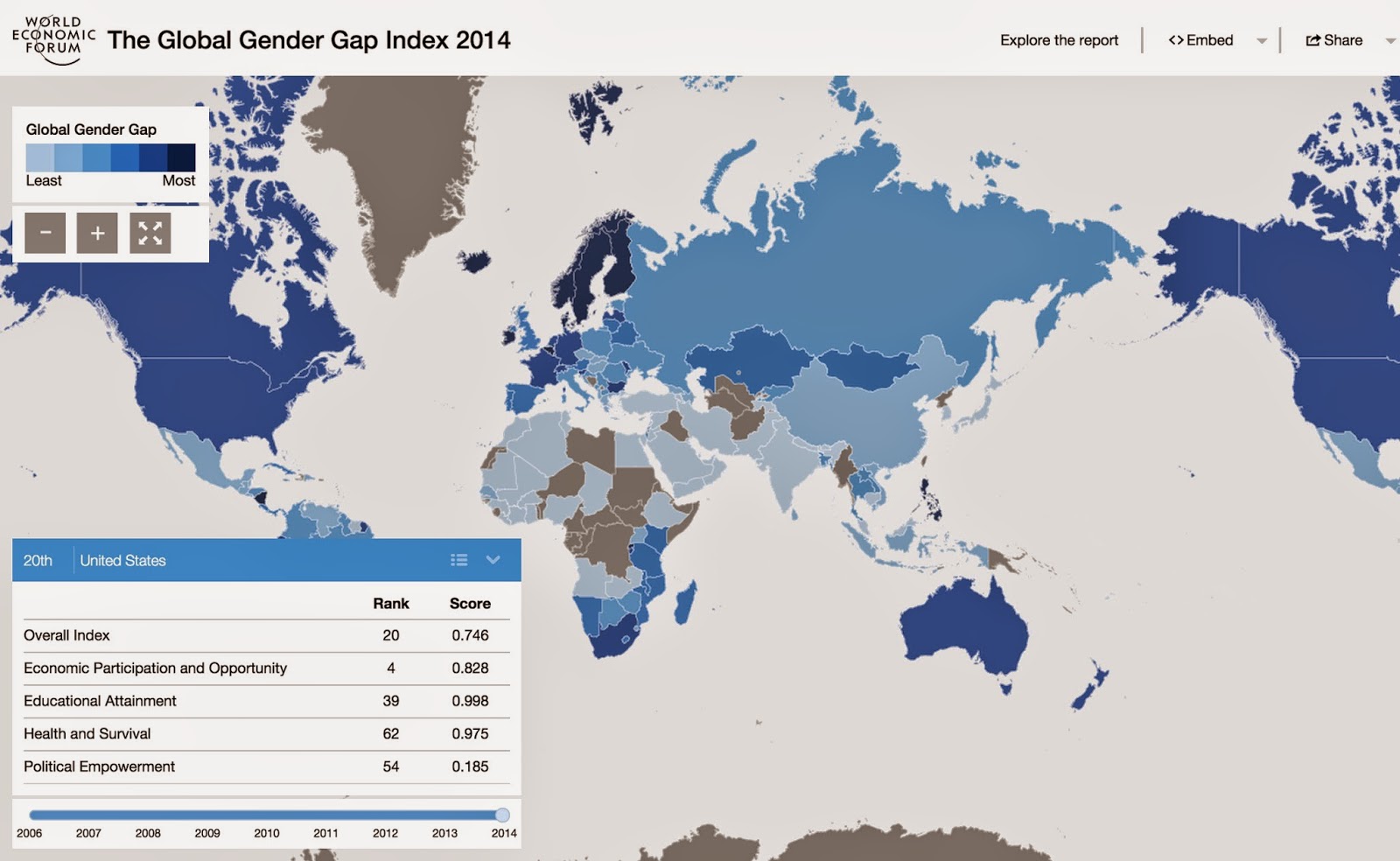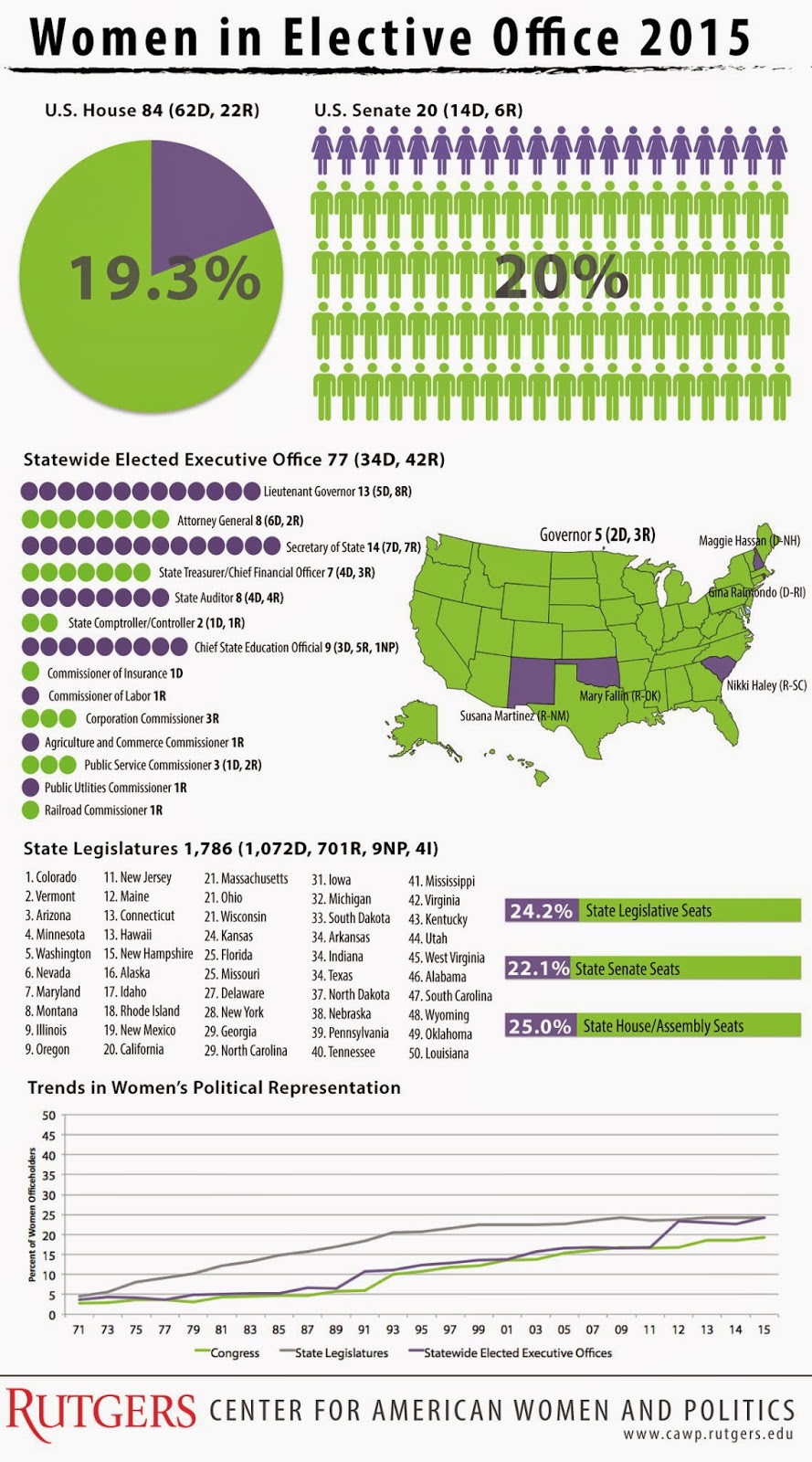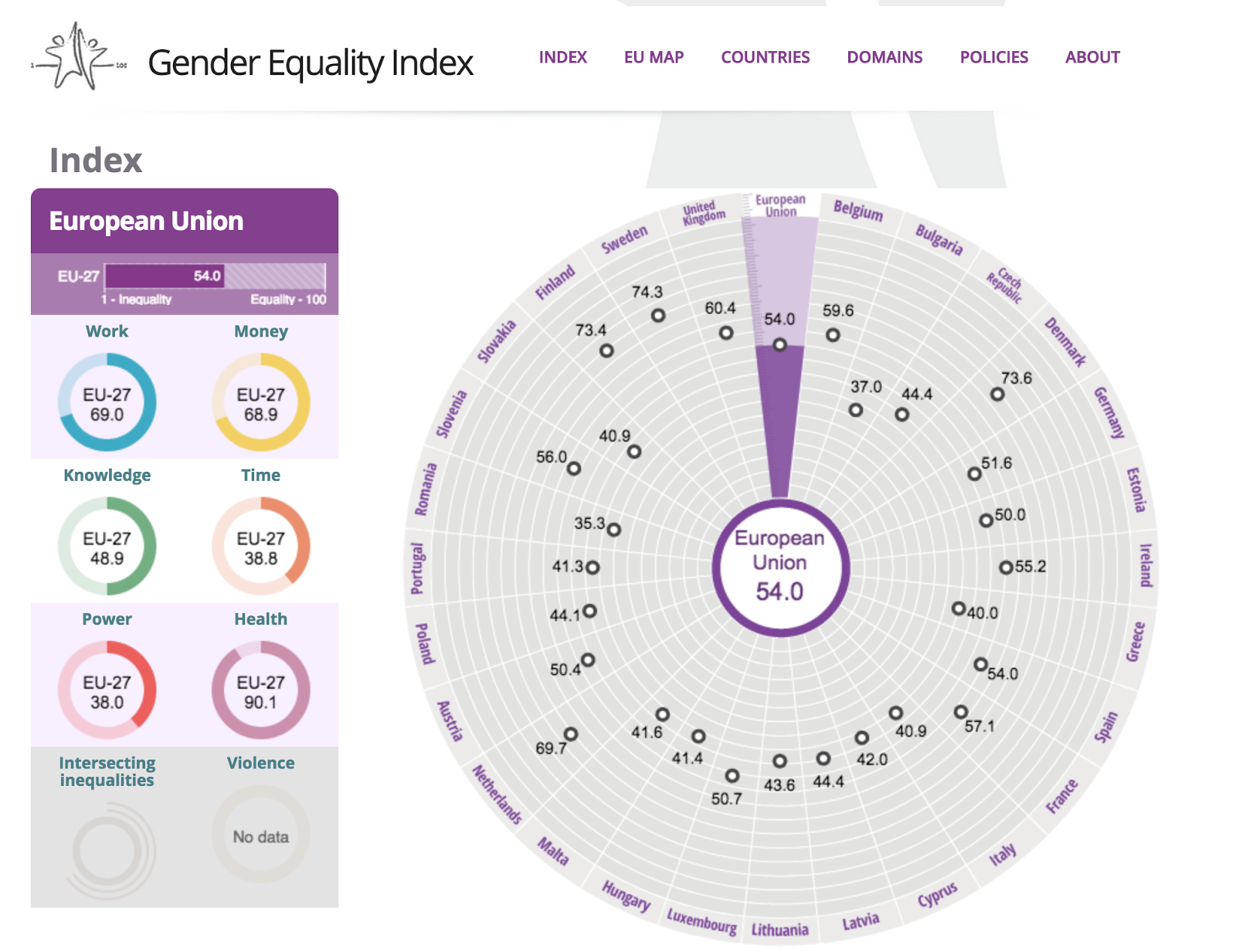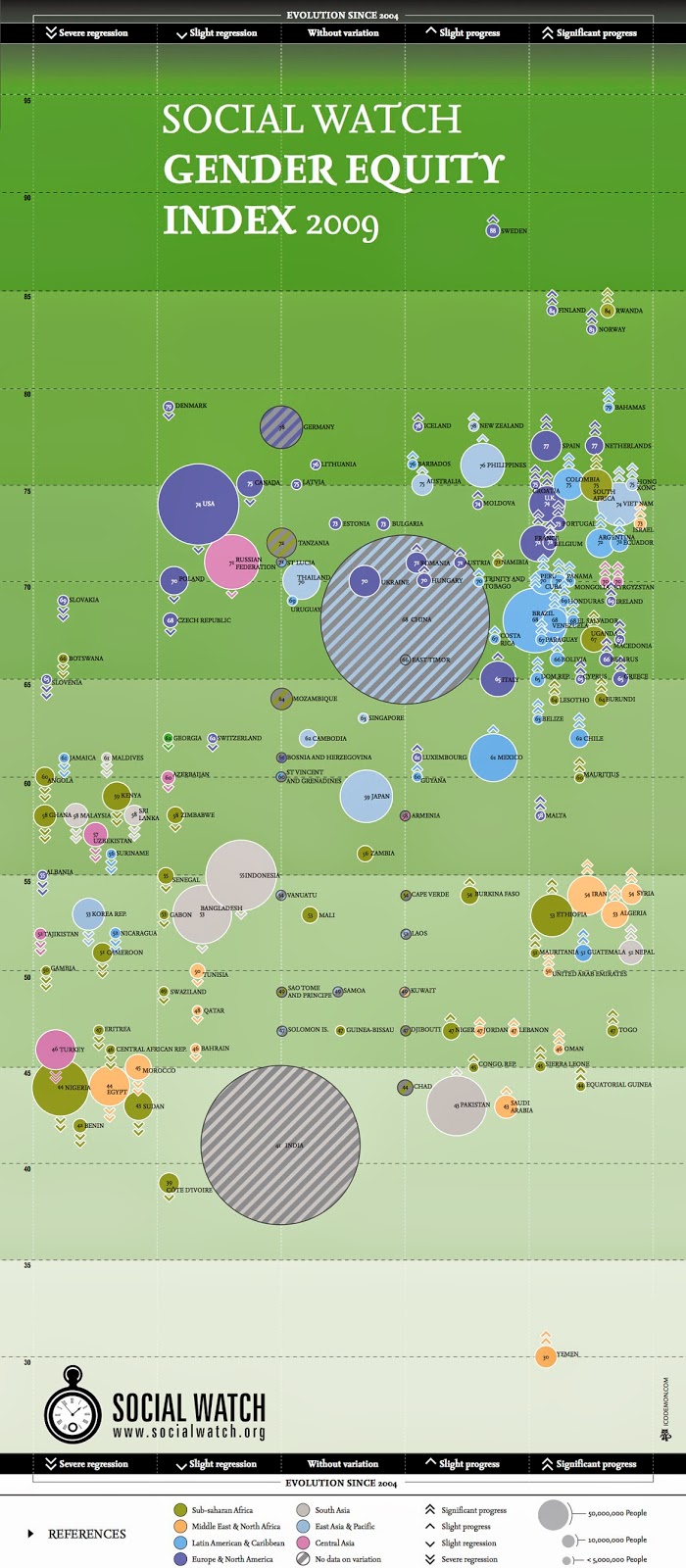Astronomy



Despite their shortcomings, these statistics help us keep tabs on progress (and setbacks). The infographic I keep coming back to is the one below, showing evolution in the Gender Equity Index for each country over time. The columns indicate countries with severe regression, slight regression, without variation, slight progress, and significant progress. I haven't been able to find an updated version of this infographic, but comparing more recent statistics, it does appear that the U.S. has moved into the 'slight progress' column -- out of the 'slight regression' column it sadly fell in in 2009.


- The Confidence Gap And Possible Effects On Persistence And Pay
An article in The Atlantic by Kathy Kay and Claire Shipman is well worth reading and pondering. On average, women are less confident than men, with harmful consequences for equitable advancement based on ability. "Confidence, " says psychologist...
- Inspiring New Policies From Spain For Gender Parity In Stem
Last week I attended an International Astronomical Union conference on Active Galactic Nuclei, hosted by the Armenian Academy of Sciences. Over dinner, Pepa Masegosa Gallegoa, woman astronomer from Spain, described some of the initiatives her...
- Where Are All The Women Professors? Among The Recently Hired!
I recently wrote a series of posts entitled "Where are all the women professors?" here and here. I began with a simple premise: "men and women are equally capable of succeeding as professional astronomers. There is no inherent (intrinsic)...
- Too Few Women Fellows Down Under
I read a World View article in Nature this week (2 May 2013) that shocked me. It is about how few women there are in the Australian Academy of Science and was written by Douglas Hilton, head of the Department of Medical Biology at University of...
- Aaswomen For June 20, 2008
AAS Committee on the Status of WomenIssue of June 20, 2008eds. Joan Schmelz, Hannah Jang-Condell & Caroline Simpson This week's issues: 1. Culture, Gender and Math 2. Gender Issues in Math/Science Education 3. How to Submit, Subscribe, or Unsubscribe...
Astronomy
International's Women Day - Taking Stock
Not us, nor our daughters, nor our granddaughters, but perhaps our great, great granddaughters, 80 years from now, will come of age in a world with global gender equality, according to projections by the World Economic Forum. There's much to debate about those projections, but in tribute to International Women?s Day, I thought our readers might appreciate a compilation of country comparisons ? where does your country stand today with respect to gender equity?
The Global Gender Gap Index from the World Economic Forum provides an interactive infographic tracking the index since 2006. The darker the color, the more gender equitable the country. Clicking on a particular country brings up additional statistics, as shown for the U.S. below.

In all gender equity rankings, the U.S. fails in particular in terms of political empowerment. We have made small gains on this front in recent years; for example, increasing the number of women in the House and the Senate. Country's like Sweden, Canada, Rwanda (yes!), France, and others provide effective models for progress for women's participation in politics.

The more detailed gender equality index (GEI) breaks down into subcategories: work, knowledge, time, power, health, and money and provides additional insight. The figure below shows a static image of an interactive infographic comparing EU nations. Clicking on the subcategory headings in the interactive provides a comparison across countries for that subcategory.

Particularly relevant to the U.S. in the report by Social Watch on the GEI is the following quote:
Access to education, participation in science & technology (S&T) and ability to earn income are not automatically connected. Numerous studies have shown that getting more girls into science and technology education at secondary and tertiary levels does not automatically lead to increased numbers of females at higher levels of S&T institutions, or in the S&T/knowledge society workforce. Similarly, getting more women into the paid workforce does not ensure that they will become senior managers, leaders or decision makers in either the public or private sectors.Also, important to note is that the Gender Equity Index does not track with GDP. For example, Rwanda and Nicaragua both have less than $9 billion in GDP, but both rank among the top 10 countries in the world when it comes to gender equality.
Despite their shortcomings, these statistics help us keep tabs on progress (and setbacks). The infographic I keep coming back to is the one below, showing evolution in the Gender Equity Index for each country over time. The columns indicate countries with severe regression, slight regression, without variation, slight progress, and significant progress. I haven't been able to find an updated version of this infographic, but comparing more recent statistics, it does appear that the U.S. has moved into the 'slight progress' column -- out of the 'slight regression' column it sadly fell in in 2009.

Statistics aside, my favorite way to honor International Women's Day is to go out and inspire the next generation of women in STEM. For those of you doing the same, check out this well-crafted infographic to consider using in your next STEM outreach event for girls:

- The Confidence Gap And Possible Effects On Persistence And Pay
An article in The Atlantic by Kathy Kay and Claire Shipman is well worth reading and pondering. On average, women are less confident than men, with harmful consequences for equitable advancement based on ability. "Confidence, " says psychologist...
- Inspiring New Policies From Spain For Gender Parity In Stem
Last week I attended an International Astronomical Union conference on Active Galactic Nuclei, hosted by the Armenian Academy of Sciences. Over dinner, Pepa Masegosa Gallegoa, woman astronomer from Spain, described some of the initiatives her...
- Where Are All The Women Professors? Among The Recently Hired!
I recently wrote a series of posts entitled "Where are all the women professors?" here and here. I began with a simple premise: "men and women are equally capable of succeeding as professional astronomers. There is no inherent (intrinsic)...
- Too Few Women Fellows Down Under
I read a World View article in Nature this week (2 May 2013) that shocked me. It is about how few women there are in the Australian Academy of Science and was written by Douglas Hilton, head of the Department of Medical Biology at University of...
- Aaswomen For June 20, 2008
AAS Committee on the Status of WomenIssue of June 20, 2008eds. Joan Schmelz, Hannah Jang-Condell & Caroline Simpson This week's issues: 1. Culture, Gender and Math 2. Gender Issues in Math/Science Education 3. How to Submit, Subscribe, or Unsubscribe...
